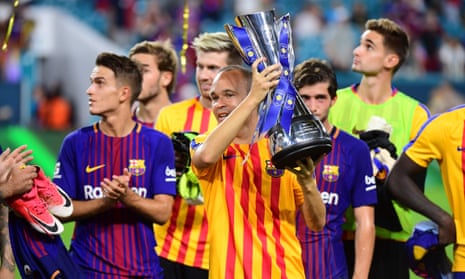On Saturday night a sellout crowd of 66,014 spectators footed between $240 (£183) and $3,500 (£2,665) to watch a pre-season friendly between Real Madrid and Barcelona at Miami’s Hard Rock Stadium, the pièce de résistance of the two-week summer exhibition tour featuring high-profile European clubs known as the International Champions Cup. The rights holder ESPN delivered the type of blanket coverage more typical of a Super Bowl or World Cup final, committing no fewer than 25 on-air personalities to south Florida and broadcasting live on location throughout the week.
This is to say nothing of the 35,728 fans who paid $20 to $30 – plus parking – to watch both clubs’ training sessions on Friday night.
The breathless mania surrounding the so-called Sunshine State Clásico – the first meeting between the two Spanish arch-rivals to take place outside Europe in 35 years – was hardly an outlier. Behold the eye-popping attendance figures in the past fortnight to watch clubs from thousands of miles away work off their offseason cobwebs: 65,109 for Real Madrid v Manchester United at Levi’s Stadium in Santa Clara; 67,401 for the first Manchester derby off English soil at Houston’s NRG Stadium; 82,104 for Barcelona v Juventus at MetLife Stadium outside New York – better than the average attendance of all but one National Football League team during the 2016 season.
This is heady stuff in a nation with an alleged hereditary aversion to the world’s most popular sport.
For decades Americans have been drilled for the day, always just around the corner, when soccer would graduate from cult interest buried in the agate type of newspaper sports sections to the mainstream realm of baseball, football, basketball and ice hockey: the traditional major leagues that comprise the national sporting conversation. First it was the North American Soccer League of the 1970s that augured the shift. Then the 1994 World Cup, the first in the US. And any number of plot points in between.
But if the enthusiastic public response to these off-season friendlies is any indication, that day is here.
These exhibitions, brought together in a loosely organized tournament format spanning 11 days and 12 venues, have only grown bigger and more numerous in recent years.
The man behind the enterprise is the soccer promoter Charlie Stillitano, who has made a cottage industry of organizing the pre-season tours of the world’s top clubs over the past decade and a half. The companies have gone through different financial backers and names – remember the ChampionsWorld or the World Football Challenge? – but the constant has been Stillitano, the former Princeton soccer captain and general manager of Major League Soccer’s New York/New Jersey MetroStars, who has finally discovered his calling as a dealmaker and power broker.
Today Stillitano serves as chairman of the International Champions Cup, seducing European clubs on the promise of fertile commercial soil – and appearance fees reportedly in the $25m range – while selling American sports fans on the allure of the megawatt stars and top-flight soccer that MLS cannot offer. The ICC is in its fifth summer and, reportedly, a profitable enterprise after operating in the red for previous editions.
The gradual success of these exhibitions can be chalked up to a couple of factors. First, the annual midsummer jaunt is scheduled during the badlands of the American sporting calendar. The NBA and NHL have wrapped up months ago and the NFL and college football are only just starting training camp, leaving only mid-season baseball on the radar. That and the MLS, which can’t be thrilled about sharing the spotlight with its European brethren as it struggles for a foothold in its own domestic market.
Second, and perhaps more crucially, the ICC sells their English and Spanish media rights in a single package, a rarity in a trade that typically hawks them in separately in order to maximize value. The bilingual package gives ESPN a chance to own a major US soccer event in both languages.
For marketing purposes the International Champions Cup bristles at the characterization of these matches as friendlies or exhibitions. Still, the fact Americans are turning out in vast numbers to watch glorified scrimmages is proof there’s an appetite for elite soccer – from the coastal elites to the heart of Texas. This is nothing like the NFL’s ongoing foray with regular‑season games in London. Yes, the star players are contractually obliged to play a designated number of minutes in ICC matches. But unlimited substitutions can mean an entire half (or more) watching second- or third-team players fight for their spots. And the results themselves: they don’t count in the standings.
But that has not stopped the people from turning out in droves, even during a tour that on four occasions went head-to-head with Gold Cup knockout stage matches, conflicts that directly undercut a crucial source of fundraising for Concacaf, which funds age-group championships and development programs in 41 member countries. But have we reached a point of oversaturation? Might the trend finally have plateaued?
“The US is a large market for sport in general and soccer specifically,” Concacaf’s general secretary, Philippe Moggio, said in a statement last week. “The interest we see for exhibition matches and other friendly games demonstrates the tremendous – and growing – overall demand for soccer in this country.”
The closing match of this year’s ICC takes place on Sunday when Roma faced Juventus at Gillette Stadium, home of the Super Bowl champion New England Patriots. MLS will no doubt be happy to be relieved of the competition, but whether a rising tide truly lifts all boats – and doesn’t merely fill the coffers of already outrageously rich superclubs – remains to be seen.

Comments (…)
Sign in or create your Guardian account to join the discussion